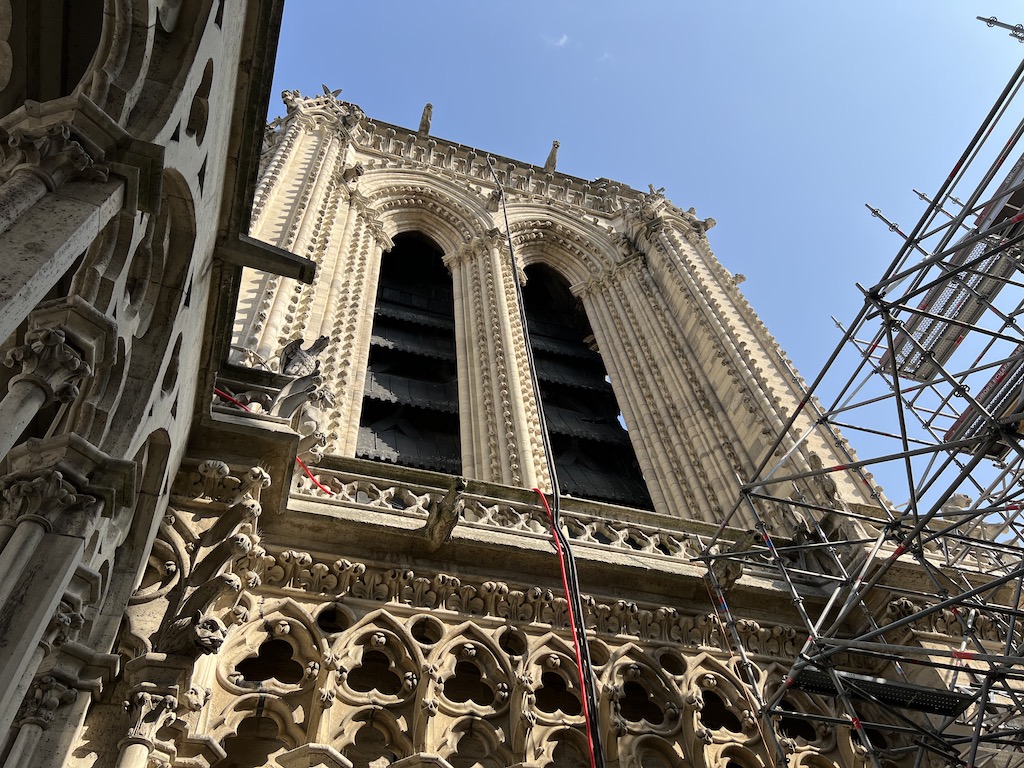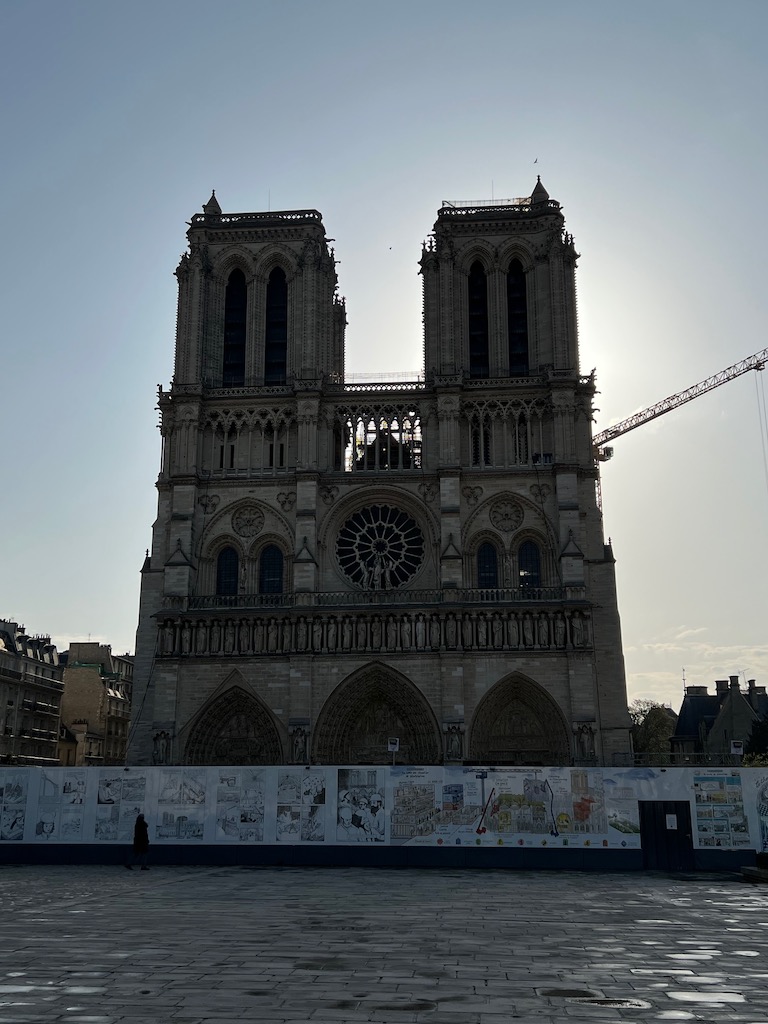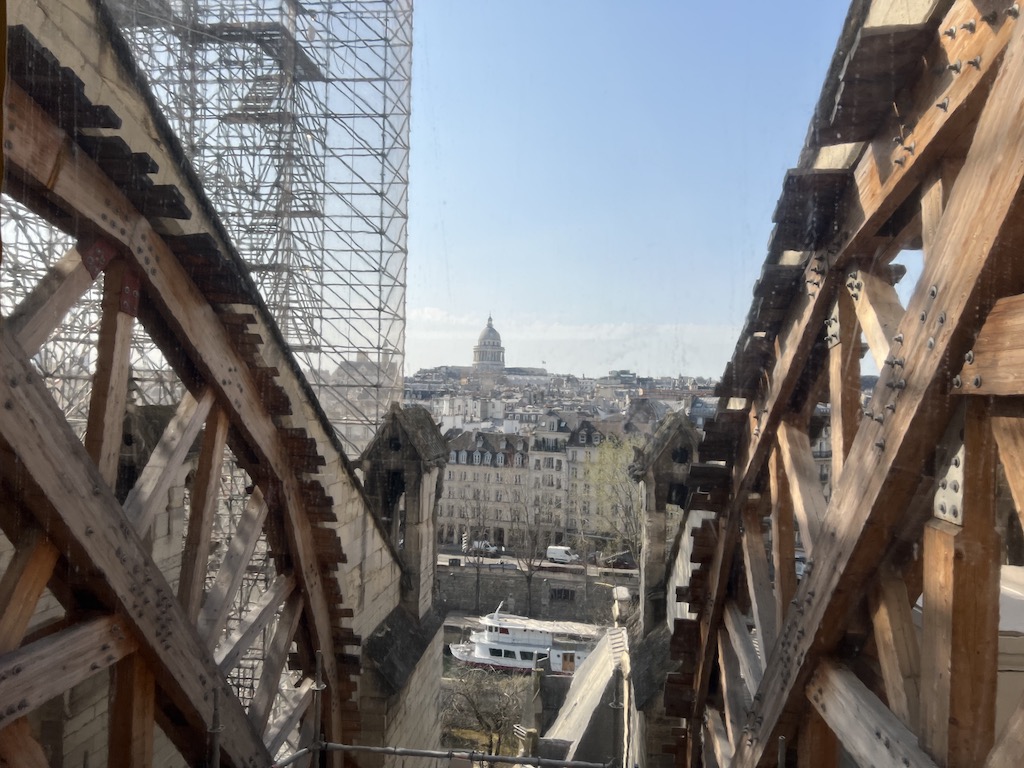
BY JUDY CARMACK BROSS
“Notre-Dame de Paris belongs to everybody on this planet.” —Michel Picaud, President of Friends of Notre-Dame de Paris
On April 15, 2019, news of the catastrophic fire at Notre-Dame in Paris stunned the world with its horrific images. On April 12, the Alliance Française of Chicago will present Michel Picaud’s incredible stories of that night, including how the crown of thorns was saved and how the restoration of Notre-Dame is challenging even French innovation. During this online presentation, he will further share the incredible news that Notre-Dame will reopen its doors in 2024, though its full restoration might continue until the end of the decade.
Mary Ellen Connellan, Executive Director of the Alliance Française of Chicago, says, “We are thrilled to welcome Michel once again to update our Francophile community on the current restoration efforts of Notre-Dame de Paris. Michel, a Parisian and ardent advocate in charge of the fundraising effort, shares his passionate commitment, depth of knowledge and firsthand presence on the evening of the fire in a way that brings to life the agonizing experience of that night and its aftermath. American donors, who represent significant support crucial to the progress of this undertaking are eager to hear the latest developments from our friend once more. It is a mutual love affair.”
A former director of international telecommunication companies and graduate of Ecole Polytechnique, Picaud serves as the volunteer president of Friends of Notre-Dame de Paris, a major instrument in fundraising for the cathedral’s reconstruction.
Picaud told us on a recent visit to Chicago how he heard about the fire: “I had spent the day at Notre-Dame de Paris on this Monday of April 15, 2019, at the beginning of the Holy Week, working on our next actions to push the funding of the restoration with a team of the local France 3 television channel, when I was called back by my colleague Andre Finot telling me that the Cathedral was on fire.
“I rushed back from home, and I struggled to arrive on Île de la Cité, where I saw huge columns of fire above the building. My wife had wanted to accompany me to support me in this ordeal, and we spent the night observing from the parvis of Notre-Dame the progress made by the firefighters of Paris, who struggled to extinguish the fire.”
He says the turning point was probably around midnight when the fire was eventually stopped in the wooden belfry of the North Tower. This fantastic achievement certainly saved the building from a complete destruction.
Chicago architect and photographer Tom Rossiter, an avid supporter of Friends of Notre-Dame, will be in conversation with Picaud for the Alliance program. When Rossiter began an Architecture Revealed series in 2016, his love of the history, architecture, and religious significance led him to choose Notre-Dame for this body of work, which focuses on the most important buildings in the world.
“I was devastated when it burned and reached out to Michel and Andre Finot with an offer to make a fine art edition of prints to benefit the rebuilding,” he recalls. “We became good friends on a visit to Chicago where we put on a joint presentation. In July 2021 Michel and Andre allowed me into the Cathedral to photograph. There was danger due to the amount of lead and visitors had to go through a complicated process that began with a locked gate, then a mandatory half-hour briefing on lead precautions, then the removal of all of your clothing, which was replaced with underwear, socks, a hazmat suit, rubber boots, and hard hat.” Everything else went into a garbage bag.
On the completion of the tour, Rossiter remembers was required to take a shower—with a special LVMH soap, no less—and deposit the hazmat gear into the aforementioned garbage bag.
He says the photos of the work in progress that he captured are illustrative of the state of things at that time: “You are able to see the black metal of the Fleche that crashed through the roof structure allowing the fire to penetrate the sanctuary. You see how close the roof damage was to destroying the North Rose Window. You can also see Michel speaking with one of the architects in a restored chapel to get to witness the finished product.”
Picaud says that the initial efforts following the fire were to safeguard the cathedral, which was at risk of suffering additional damages. This first phase lasted until mid-2021, including such major undertakings as the removal of the burnt scaffolding of the spire, the consolidation of the walls of the building and of the 24 large flying buttresses, the first measures of lead decontamination following the melting of the covering of the roof and of the spire, the removal of the stained glass windows of the upper part of the nave and of the statues at risk of falling down, the test restoration of the first two chapels of the ambulatory (Saint Ferdinand) and of the nave (Notre-Dame de Guadalupe), and the dismantling of the pipes of the Grand Organ.
Since then, he explains, the preparation of the reconstruction itself has begun with the installation of scaffoldings inside the building in the choir, in the transept and in the nave, plus the propping up of the vaults with large hangers to prepare the consolidation of the vaults, and the replacement of the missing vaults—about 20 percent of them were destroyed. The decision was made mid-2020 to rebuild as-is the well-known spire and roof that existed before the fire and were due to Viollet-le-Duc’s restoration in the middle of the nineteenth century.
“In the past month, a team of archeologists has excavated the ground at the crossing of the transept before the installation of the scaffolding, which will be used to rebuild the spire. They have discovered remnants of the jube or a loft over a rood screen, dating to the thirteenth century, and sarcophaguses from the fourteenth century,” Picaud shares.
He believes that this bodes well for the next step of the restoration, which will consist of the rebuilding of the spire, of the vaults, and of the roof of Notre-Dame de Paris for her reopening to religious services and to visitors before the end of 2024.
As a native Parisian, Picaud has always felt a Notre-Dame connection: “Notre-Dame has always been, for me, the center of the city, both from a political standpoint and from a religious one, as well as it is the church of the Archbishop of Paris. I had begun two years before the fire to raise money to fund the restoration of a building that was already in a very dire state. Needless to say that the catastrophe of April 15, 2019, came as a shock, as the extent of what now needs to be done is far beyond what we had to do in the beginning.”
But it was the outpouring of support from all over the world, and especially from the United States, that made him realize that Notre-Dame de Paris belongs not only to Parisians, to the French people, or to the Christian believers, but to the whole world: it is a symbol of Christianity in its real sense, which is a universal one going beyond the barriers of citizenship, race, or faith.
Above all, he is proud of being part of the team in charge of saving Notre-Dame. “My job is to fund the restoration and to ensure on the long run that we will have the resources to maintain the cathedral and to avoid any new terrible event like the one of 2019,” he explains. “The monument belongs to the State. The Church of Paris will resumex religious services after the reopening. My job is to contribute to the Renaissance of Notre-Dame on behalf of the tens of thousands of donors from all over the world, and especially on behalf of the so generous American donors.”
He hopes to share with their American friends his strong belief that the restoration of the Notre-Dame so loved by all is progressing very well—and wouldn’t have been possible without the support of its American donors: “We are now more than 40,000 friends of Notre-Dame de Paris. We need to more of them to join us, as the project will last beyond 2024. American donors are key to this project. I think American people realize that they must give back this world heritage to their children and to their grandchildren for centuries to come. Notre-Dame de Paris is part of the world heritage through her rich history and also through the cultural components linked to the cathedral, be it The Hunchback of Notre-Dame by Victor Hugo, the films and the musicals derived from it, the characters of Quasimodo or of Esmeralda. And it will remain so in the future for the benefit of the next generations.”
***
“Notre Dame Paris: Fire and Restoration” will be streaming live online at 12:00 pm CDT on April 12. For further information, visit af-chicago.org.
Photos courtesy of Michel Picaud, unless otherwise mentioned.

















